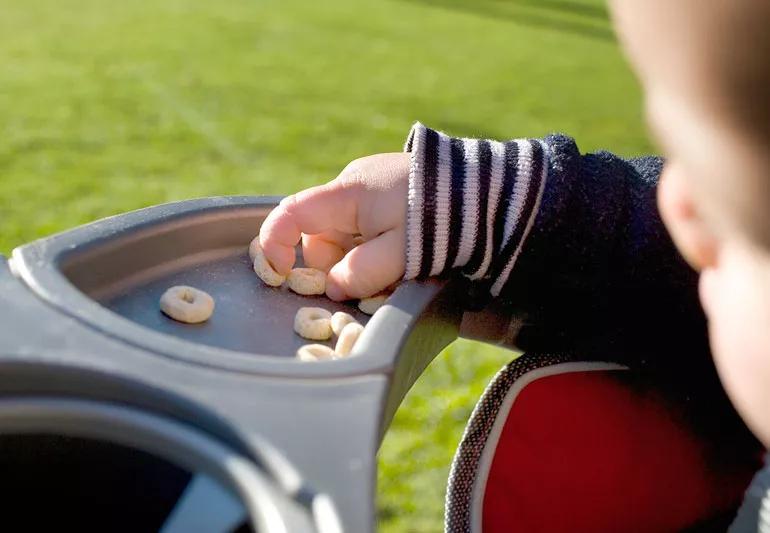
Like a gateway to a new world, the development of pincer grasp lets your baby experience life in a whole new way. No longer are they limited to crudely pushing, pulling and palming the objects around them. Now, they can precisely pick up small items and place them right where they want them.
Cleveland Clinic is a non-profit academic medical center. Advertising on our site helps support our mission. We do not endorse non-Cleveland Clinic products or services. Policy
How does this marvelous skill develop, and how can you nurture it? Pediatrician Lisa Diard, MD, fills us in.
Simply put, pincer grasp is the ability to use your thumb and index finger to pick up small objects. Grownups do it all the time when we reach for a pen, slip a button through its buttonhole or plug our phones into a charger.
As any caregiver will tell you, babies aren’t born with this ability. Instead, they acquire it over their first year of life. While pincer grasp development may not seem as thrilling — or as obvious — as baby’s first steps or first words, it’s still a cause for celebration. It’s an essential skill for future achievements like self-feeding, self-dressing and even learning how to grasp a pencil.
It takes nearly a year for babies to reach the point where they can pick up and manipulate small objects with precision and grace.
Babies’ fine motor skills pass through several developmental stages before they reach this major milestone:
At this point, babies enter a whole new world. Now, important skills like using a spoon, putting on socks — even holding a pencil when they eventually enter school — are literally within their grasp!
When it comes to developing fine motor skills, practice makes perfect. That’s why it seems, from their earliest days, babies are hardwired to touch, tug or pull on anything that comes their way.
You can play an important role in helping your baby perfect their grasping skills.
Providing safe objects and activities that encourage your baby to touch, explore and manipulate is a good way to help them develop the strength, dexterity and coordination they’ll need to develop a functional pincer grasp.
But first, an important safety warning. “Small objects present a choking hazard,” Dr. Diard reminds us. “So, any activity involving small objects must be closely supervised. We don’t want them getting into baby’s mouth.”
Buttons, coins and small plastic toys are common dangers to watch out for. Even certain foods can be a hazard. According to the U.S. Centers for Disease Control and Prevention (CDC), potential choking hazards include pieces of hard foods like apples and carrots; uncut grapes and cherries; hot dogs; cookies; chewing gum; and round or hard candies like gummy bears and jelly beans.
But given appropriate supervision, Dr. Diard suggests several types of toys and activities that can encourage pincer grasp development:
Your baby or toddler might also enjoy:
By the time babies reach their first birthdays, their dexterity is well-developed. “That’s when they can move on to things like trying to turn pages in a book or helping to take their socks off,” says Dr. Diard.
Some babies can even learn how to snap their fingers around this point, an activity that’s sure to bring smiles to everyone!
Most experts agree: Babies learn best by doing, not by watching. That’s especially true when it comes to developmental milestones like the pincer grasp.
To help families make thoughtful decisions about their use of computers, phones and televisions, organizations like the American Academy of Pediatrics and the American Child & Adolescent Psychiatry have developed screen-time guidelines.
Among their recommendations:
Dr. Diard agrees: “There is no role for screens for children less than 2 years of age. Sitting in front of a screen not only inhibits creative play, but it also inhibits physical activity and interactions with family.
Even if they are just running in the background, televisions and computer screens can inhibit childhood play. They should be kept off, even if your baby is not watching them.”
While it might not get the fanfare of baby’s first steps, the ability to pinch small objects between the tips of their thumb and index finger is an important milestone in your baby’s motor development. It serves as the foundation for important tasks like using eating utensils, putting on clothing and even holding a pencil or crayon.
From birth until about 1 year of age, babies typically progress through several developmental steps that eventually lead to a functional pincer grasp. Age-appropriate toys, activities and interactions with caregivers can help.
Each baby makes this journey according to their own timetable and can’t be compared to anyone else. But sometimes, you might have questions about whether your baby’s development is on track. In those cases, your pediatrician or other healthcare provider can be your best resource.